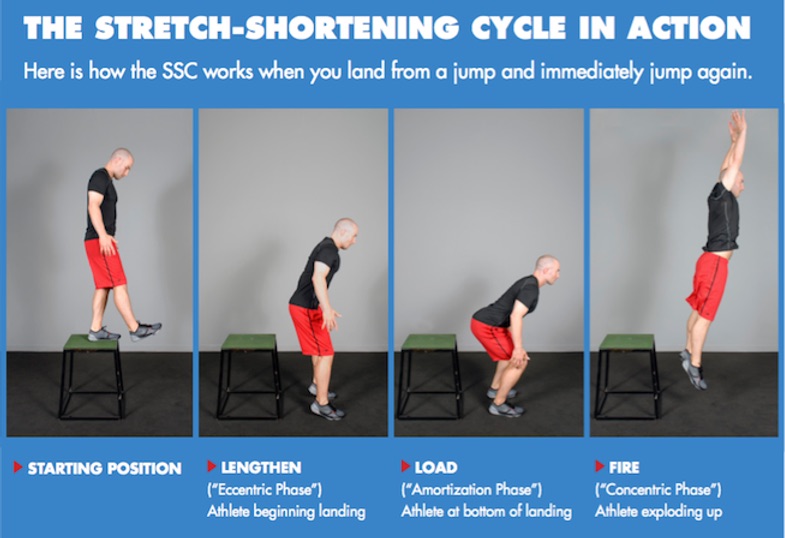High performance Lab perth
UNLOCKING POWER AND EFFICIENCY FOR ATHLETIC PERFORMANCE: EXPLORING THE STRETCH SHORTENING CYCLE.
High performance Lab perth

What is the Stretch Shortening Cycle?
The Stretch Shortening Cycle (SSC) is a mechanism of muscular contraction that utilises the elastic properties of muscle-tendon units (MTUs) to generate force and power. This mechanism involves the pre-contraction of muscle fibers to stretch the MTUs, which are then rapidly shortened to produce a powerful concentric contraction. The SCC has been shown to be an important factor in athletic performance, as it is involved in activities such as jumping, sprinting, and throwing.
Physiology of the Stretch Shortening Cycle:
The SCC involves a complex interplay of physiological factors, including the elasticity of MTUs, muscle activation and recruitment, and neural control. The elastic properties of MTUs allow for the storage and release of energy, which is then used to enhance force and power production during concentric contractions. Muscle activation and recruitment are also critical factors in the SCC which is achieved through various phases, it’s these phases that determine the amount of force and power that can be generated.
These phases occur in sequence of muscle actions involving an eccentric (lengthening), amortization (transition), and concentric (shortening) phase. It’s this sequence of events that enables muscles and tendons to store elastic energy during the eccentric phase and then release it during the subsequent concentric phase, resulting in a more forceful and efficient movement. See a detailed explanation of each phase below:
1. Eccentric Phase:
During the eccentric phase, the muscle lengthens under tension. It is often initiated by an external force, such as gravity or an opposing force, and involves the activation of the muscle lengthening agonists and the antagonists. This phase is best described as the preloading or stretch phase, where elastic energy is stored within the muscles and tendons.
2. Amortization Phase:
The amortization phase is the transitional phase between the eccentric and concentric phases. It is a brief isometric pause that allows for the reversal of the movement direction. The duration of this phase is crucial, as a shorter amortization phase enhances the effectiveness of the SSC by maintaining the stored elastic energy.
3. Concentric Phase:
The concentric phase follows the amortization phase, where the muscle actively contracts and shortens. The stored elastic energy from the eccentric phase is released, resulting in a more forceful muscle contraction and increased power output. This phase is best described as the explosive or propulsive phase.

(Image Source: https://www.stack.com/a/how-to-create-the-perfect-plyo-workout-program/)
Performance Impacts of the Stretch Shortening Cycle:
The SCC has been shown to be a significant predictor of athletic performance, particularly in activities that require explosive power and speed. Research has demonstrated that athletes with a greater ability to utilise the SCC have improved performance in activities such as jumping, sprinting, and throwing.
Moreover, with adequate utilisation of the SSC can be further categorised (two) during the amortization phase, these are:
-
- Fast SSC: In this phase, the amortization phase is short (less than 0.2 seconds). It allows for a rapid transition from the eccentric to concentric phase, maximising the utilisation of stored elastic energy and enhancing power output.
- Slow SSC: In the slow SSC, the amortization phase is prolonged (greater than 0.2 seconds). This phase typically occurs when the transition between the eccentric and concentric phases is slower, reducing the utilisation of stored elastic energy. As a result, power output during the concentric phase may be lower compared to the fast SSC.
Position of Research on the Stretch Shortening Cycle:
Research on the SCC has been extensive, with studies investigating its mechanisms, performance impacts, and training interventions. While the majority of research has been conducted on athletes and healthy populations, there is also interest in the SCC’s role in clinical populations, such as individuals with neuromuscular disorders or musculoskeletal injuries.
A study by Komi et al. (2008) found that training interventions aimed at improving the SSC can lead to improvements in performance in activities such as jumping and sprinting. Another study by Kawamori et al. (2014) found that athletes with a greater ability to utilise the SCC had improved performance in sports that require rapid changes of direction, such as basketball and soccer.
Evidence-Based Best Practice Training and Testing Methodology:
Training interventions aimed at improving the SSC should focus on exercises that involve rapid changes in muscle length and utilize the elastic properties of MTUs. Plyometric exercises such as box jumps, depth jumps, and hurdle jumps have been shown to be effective in improving the SSC. Testing methods for the SCC can include a variety of measures, such as reactive strength index (RSI), drop jump tests, and countermovement jump tests.
Clinical Tests to Assess the Stretch Shortening Cycle:
Clinical tests that can assess the SCC include single leg hopping tests (AKA Pogo hops), triple hop tests, and timed hop tests. These tests can be useful in assessing the SCC’s role in athletic performance and in identifying areas for intervention in clinical populations.
Conclusion:
The Stretch Shortening Cycle (SSC) is a mechanism of muscular contraction that utilises the elastic properties of MTUs to generate force and power. The SCC has been shown to be an important factor in athletic performance, particularly in activities that require explosive power and speed. Training interventions aimed at improving the SCC can lead to improvements in performance, and testing methods can be useful in assessing the SCC’s role in athletic performance and in identifying areas for intervention in clinical populations.

